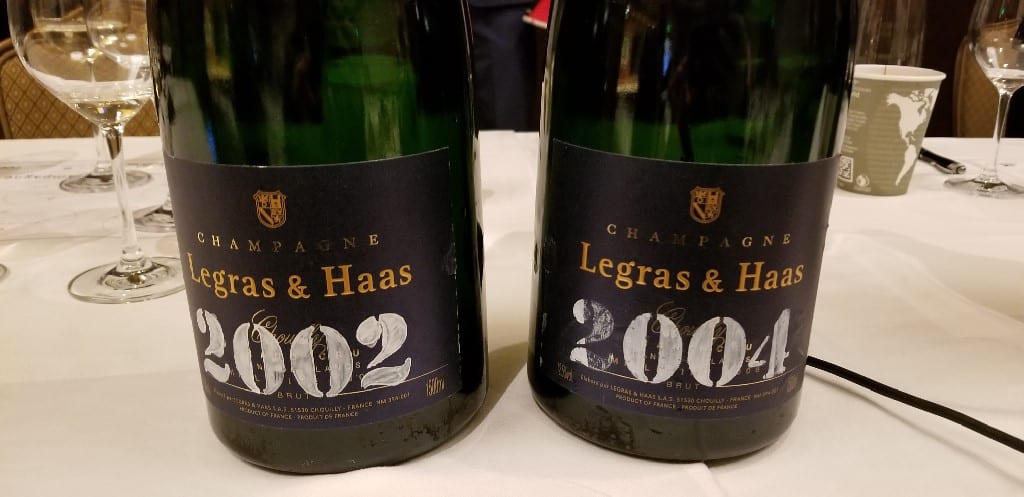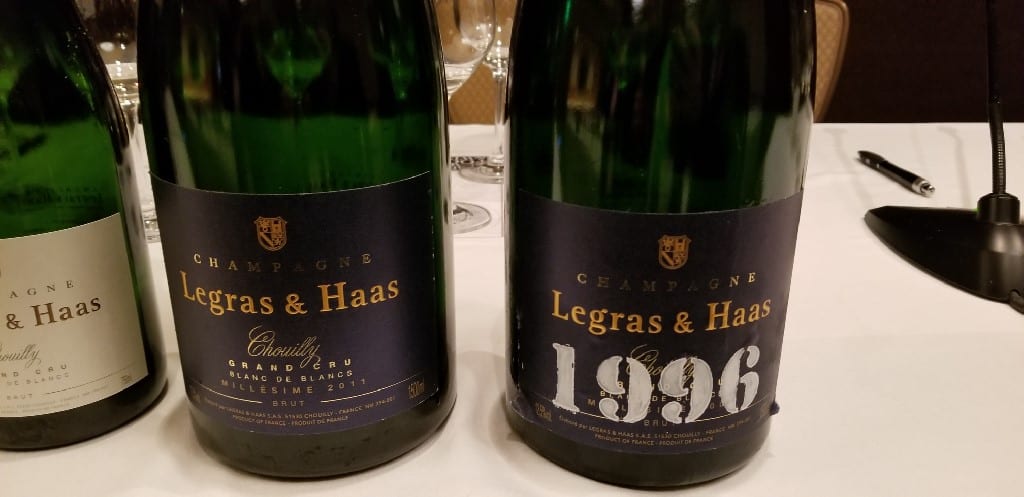
30 Apr Discovering Champagne Legras et Haas
Who doesn’t love Champagne!?! I know I do. There are so many brands out there…..well-known ones and lesser-known ones. It is always fun to try new brands and recently, while at Pebble Peach Food & Wine, I was introduced to a new brand – Champagne Legras & Haas, which I wrote about in the Napa Valley Register and share here.
As a lover of Champagne, and all sparkling wines for that matter, I can never pass up a glass of bubbles. So, as I wandered around the opening night party at Pebble Beach Food & Wine, I found myself stopping at every table that was pouring Champagne.
One of these tables was Champagne Legras et Haas. Standing behind the table was Jerome Legras, who poured me the Legras et Haas Blanc de Blancs Grand Cru Chouilly 2002. It was rich yet elegant, intense yet delicate. I was smitten. The next day, I attended a seminar with Jerome Legras and Master Sommelier Geoff Kruth to learn more about this Champagne house.
Established in 1991, Champagne Legras et Haas was founded by François Legras, a winemaker, and his wife Brigitte Haas Legras, a sommelier. What started as a retirement project has become a family business with Jerome and his brothers working with their parents.
Champagne Legras et Haas is not a Grower Champagne because they purchase some fruit. They are not a Négociant because they own their own vineyards and 80 percent of what they produce comes from their estate vineyard. The best way to categorize Champagne Legras et Haas, if you must categorize them, is as a Boutique Champagne House.
The Legras family is located in Chouilly in the north of the Côte des Blancs. They own 15 hectares (37 acres) in Chouilly of Grand Cru Chardonnay. Here the Kimmeridgian clay soils, like what is found in Chablis, lend towards a more tender, softer style of Chardonnay. They also own 10 hectares (24.7 acres) in Vitry, also planted to Chardonnay, and six hectares (14.8 acres) in Les Riceys, where Pinot Noir is planted. The Legras family does not use any herbicides and they work with low yields in order to produce balanced elegant wines that express both fruit and minerality. As Jerome Legras explained, “There is no either/or between minerality and well-preserved fruit in wine. The two do not have to be antagonistic.”
The wines
Legras et Haas Blanc de Blancs Grand Cru Chouilly Brut NV – This wine represents what Legras et Haas does. The wine is made from grapes from more than 35 separate plots, offering a snapshot of where they are located. The wine is stainless steel fermented and undergoes malolactic fermentation. At only 6 grams dosage, the wine is a dry brut. It was disgorged 12 months prior to when we tasted it. The nose has an intensity and depth yet it is delicate with citrus, lime, crisp apple and mineral aromas. The wine is zippy, racy and clean on the nose with medium depth with great acidity.
Legras et Haas Blanc de Blancs Grand Cru Chouilly Extra Brut NV – When making an Extra Brut, Jerome explained that they lean towards riper lots as you need a fundamental intensity and richness and enough mouthfeel to handle the dryness. The wine is stainless steel fermented and undergoes malolactic fermentation. Chalky and citrus notes dominate. On the palate, the Champagne is refreshing, light and elegant. It is acidic but not tart and is about minerality and austerity while still being concentrated.
Legras et Haas Blanc de Blancs Grand Cru Chouilly Les Sillons 2013 – This vintage Champagne comes from a single vineyard. Les Sillons offers more austerity and acidity than other vineyards. The wine is fermented in oak barrels with full malolactic fermentation. The wine has crispy red apple, pineapple and floral aromas. It is an austere wine and yet is balanced with exotic fruit notes.
Vertical of vintages
The next five wines we tasted was a vertical of vintages from the same cuvee. The grapes come from a plot on a hill that gives the most acidity to the wines. The wines were each served in magnum, a special characteristic of Champagne Legras et Haas as they sell as least two-times as many magnums as the average Champagne house.
Legras et Haas Blanc de Blancs Grand Cru Chouilly 2011 En Magnum Oenotheque – A classic high-yield vintage, Legras et Haas will press less juice if needed to maintain the quality. The wine has a waxy, lanolin and unsweetened coconut note and is savory on the palate.
Legras et Haas Blanc de Blancs Grand Cru Chouilly 2004 en Magnum Oenotheque (disgorged January 2010) – A big vintage, this wine is currently, as Jerome described it, a teenager. The fruit is still there with notes of extremely ripe lemon and sea shells. This wine is still fresh, but it is shifting into a real vintage wine.
Legras et Haas Blanc de Blancs Grand Cru Chouilly 2002 en Magnum Oenotheque (disgorged January 2006) – A beautiful wine, it is restrained but developing. It has a very aromatic bouquet of white flowers and lemongrass. It is round and creamy on the palate, with a line of acidity that heads straight down the center of the tongue. This wine is structured and powerful with lots of finesse.
Legras et Haas Blanc de Blancs Grand Cru Chouilly 1996 en Magnum Oenotheque (disgorged January 2000) – In 1996, the sugar ripeness in the vineyard was achieved but phenolics did not catch up. The wine has aromas of baked apple and citrus with a little touch of caramel and roasted coffee. On the palate, there are notes of tarte tatin and lemon. This is an intellectual wine, that at 23 years old, does not taste that old.
Legras et Haas Blanc de Blancs Grand Cru Chouilly 1995 en Magnum Oenotheque (disgorged January 1999) – This wine is a bit more aged but is still fresh. It is mature and yeasty with a note of Sweet Tart candies. It is quite sexy on the palate.
Champagne Legras et Haas wines are expressions of origin. Master Sommelier Geoff Kruth, who also tasted the wines for the first time, explained that “Champagne takes a lot of thought and precision and I see that in these wines.” They are wines of meticulousness and craft but also so drinkable and enjoyable. I am excited to discover a new Champagne producer.
Read the original story in the Napa Valley Register.
Discover more from Please The Palate
Subscribe to get the latest posts sent to your email.






